Inleiding
In this chapter we look at the wind-driven surface-ocean currents that dominate the central regions of the open ocean.
In the subtropics, these currents form huge gyres with warm, fast boundary currents on the western side of the oceans and
slow, cold boundary currents on the eastern side.
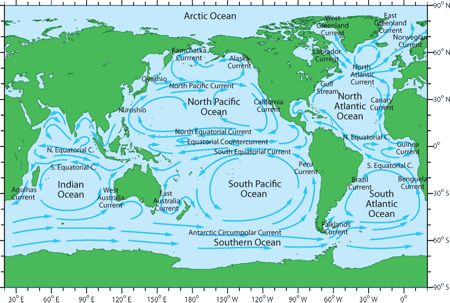
Map of global surface currents. Bron: NOC
The long-term average pattern of ocean surface currents is plotted in the map above. Taking a closer look at the map you
should be able to identify the main features:
- Five subtropical gyres: two in the Atlantic, two in the Pacific and one in the Indian Ocean
- A belt of eastward-flowing equatorial currents to the north and south of the equator in all three oceans
- Weak equatorial counter currents that separate the northern and southern hemisphere gyres in each ocean
- Mid-latitude belts of westward-flowing currents: the main one circling the Antarctic in the southern hemisphere,
and two smaller belts diverted northwards by land in the North Atlantic and North Pacific.
- Two subpolar gyres: one in the North Pacific and one in the North Atlantic
This global pattern is created by interaction between the prevailing (average) winds, the rotation of the Earth and the shape
of the ocean basins. The rest of this chapter will look at what controls these currents and examine their characteristics in
more detail.
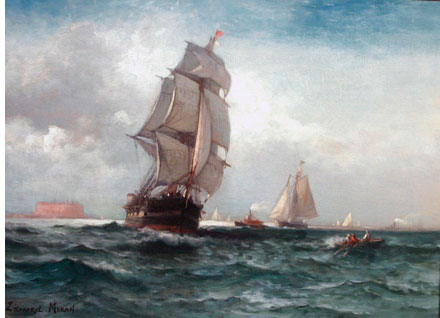
New York Harbour in the 18th Century by Edward Moran.
Courtesy of
Vallejo Gallery
Why the big difference?
In 1769 or 70 the Board of Customs at Boston complained that mail ships between London and New York took a fortnight
longer to cross the Atlantic than merchant ships sailing from Falmouth to Rhode-Island. The authorities thought this was
just an excuse to move the mail away from New York, and asked Benjamin Franklin for his opinion.
Initially Franklin also thought the complaint must be unfounded. New York and Rhode-Island are barely a day's sailing
apart, so a fortnights difference in sailing time from England seemed unlikely. Not only that, merchant ships were
usually deeper laden and more weakly manned than the mail ships. However, after talking to a captain with local knowledge, Franklin realised that the
complaint was justified.
-
Looking at the SST and current map below, can you explain why it should take so much longer to travel from Falmouth
to New York than from London to Rhode Island? [Hint: Look at the main currents, and the eddies between them.]
-
How could measurements of water temperature help navigators take advantage of the current when sailing from America
to Euroope and avoid it when sailing from Europe to America?

Satellite image of sea surface temperature (SST) with the Gulf Stream (1) and Labrador Current (2) marked.
Eddies mix the warm and cold water along the front between the two currents.
Eddies with a cold centre rotate in
an anti-clockwise direction. Eddies with a warm core rotate in a clockwise direction.
Franklin went on to map the Gulf Stream, and explain how navigators could choose the best route simply by lowering a
bucket over the side and measure the water temperature. Even today oil tankers and other traffic save time and money
by staying in the Gulf Stream when sailing north- and eastwards, and avoiding it when sailing south- and westwards.
Of course, modern ships often have electronic navigation systems and satellite maps of temperature to help them.
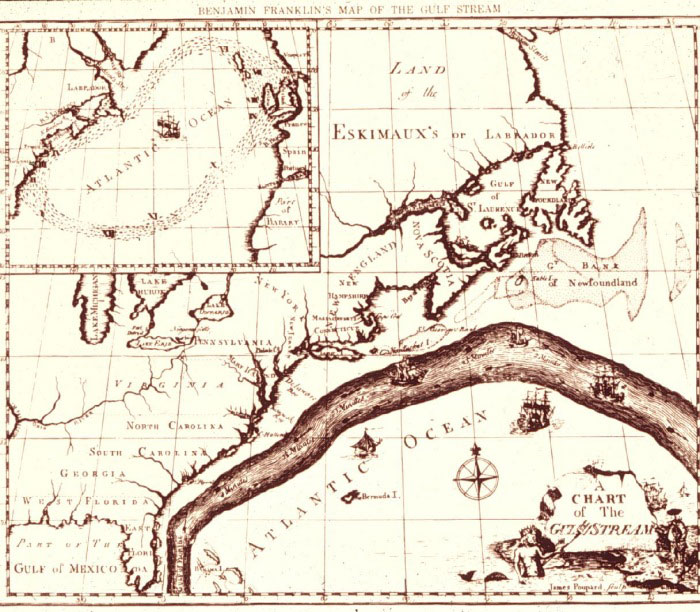
Franklin's map of the Gulf Stream (click on the image for a larger version in a new window).
Bron: NOAA Central Library

Portrait of Benjamin Franklin (click on the image for a larger version in a new window).
Bron: National Science Foundation
Why the big difference?
In the 18th century mail ships from London to New York took two weeks longer than merchant ships from Falmouth to Rhode Island.
Benjamin Franklin worked out why.
Can you?
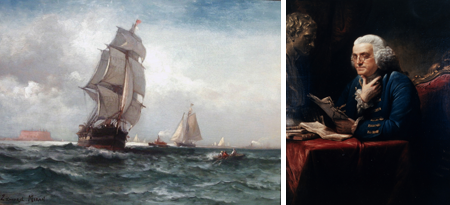 Left: New York Harbour in the 18th Century. Courtesy of
Vallejo Gallery.
Left: New York Harbour in the 18th Century. Courtesy of
Vallejo Gallery.
Right: Benjamin Franklin.
Courtesy of National Science Foundation.
Using satellites to study current flow
The global current patterns have been known for some time. Satellites are now making it easier to study how
the flow of these currents vary with with seasons and from one year to the next. As a result we are now able to link
changes in ocean currents to recruitment of fish stocks, bleaching of coral reefs, or changes in weather patterns that
cause floods or droughts. El Nino - shown below - is an example of this.
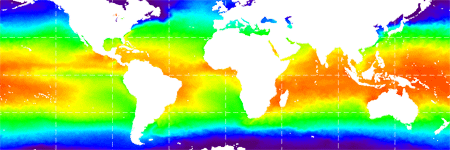
January 1997: Normal pattern with cool water from the Humboldt current reaching the eastern
tropical Pacific and seasonal upwelling off Peru (click on image for a larger version). Bron: NOAA.
This chapter will cover
- The global belts of prevailing winds
- The ocean surface circulation driven by these winds
- The ocean gyres formed by the main surface currents
- The mid-latitude westward-flowing currents
 Left: New York Harbour in the 18th Century. Courtesy of
Vallejo Gallery.
Left: New York Harbour in the 18th Century. Courtesy of
Vallejo Gallery.





